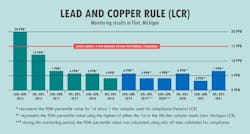Flint enters 6th year of drinking water lead compliance
The Michigan Department of Environment, Great Lakes, and Energy (EGLE) recently announced that the City of Flint’s water system has entered its sixth consecutive year of meeting state and federal standards for lead in drinking water.
Since July 2016, the city of Flint’s water system has tested below action levels of the federal Lead and Copper Rule (LCR) during 11 consecutive monitoring periods. The latest six-month monitoring period, from July 1 through Dec. 31 2021, find that the 90th percentile calculation for the city’s collected samples is at 7 parts per billion (ppb) for lead. The 90th percentile calculation of 7 ppb means 90 percent of the test results used in the calculation came in at or below 7 ppb.
This result means that the city’s water is still compliant under the new, stricter state rule that requires a fifth liter sample to better reflect the impact of lead service lines. The latest testing result is higher than the previous 6-month period result, but still well below the federal action level of 15 ppb.
Flint has conducted excavations to determine service line material composition at approximately 95 percent of the residential locations. The service line replacement program is scheduled to be completed in 2022. City officials urge any remaining water customers who may potentially have lead service lines to opt into the city’s free replacement program form.
“These latest LCR results are a testament to the unwavering commitment of our public health navigators, water advisory and community groups, our partners at the local and state levels, and this administration,” said Flint mayor Sheldon Neeley. “The fact that we’ve been able to be below LCR standards six years consecutively is key toward rebuilding the community’s trust and a stronger Flint for us all. There is still more work to be done, but this important news serves as a positive reminder of what we can achieve working together.”
The latest test results were calculated from drinking water samples drawn from 71 homes and businesses known to have lead service lines. 40 of these sites were single-family homes and other 31 were businesses and a church. This was the largest number of non-residential sites used in calculating Flint’s 90th percentile to-date and more than twice the number (12) used in the previous monitoring period. If only Tier 1 residential sites had been used the 90th percentile result would have been 5 ppb. If only Tier 2 sites had been used in the calculation the 90th percentile would have been 13 ppb.
“We’re pleased to see that Flint’s work to eliminate residential lead service lines is showing a sustained drop in lead levels across the city,” said Eric Oswald, director of EGLE’s Drinking Water and Environmental Health Division. “The data we are now seeing from the Tier 2 sites is also an important reminder to business owners to flush their lines after extended periods of stagnation that may have been caused by pandemic-related closures.”
Oswald noted that the highest lead level recorded at the 71 sites tested was 3,492 ppb at a church that has been closed during the pandemic. These results further underscore the need for active water usage to maintain water quality.
Michigan in 2018 adopted the nation’s toughest lead rules for drinking water. The state’s Lead and Copper Rule (LCR) requires that all lead service lines in the state be removed. Water supplies are required to replace an average of five percent of their lead service lines every year for the next 20 years. Starting in 2025, the rule lowers the action level to 12 ppb.
Flint’s testing results can be found by visiting https://www.michigan.gov/flintwater/.

